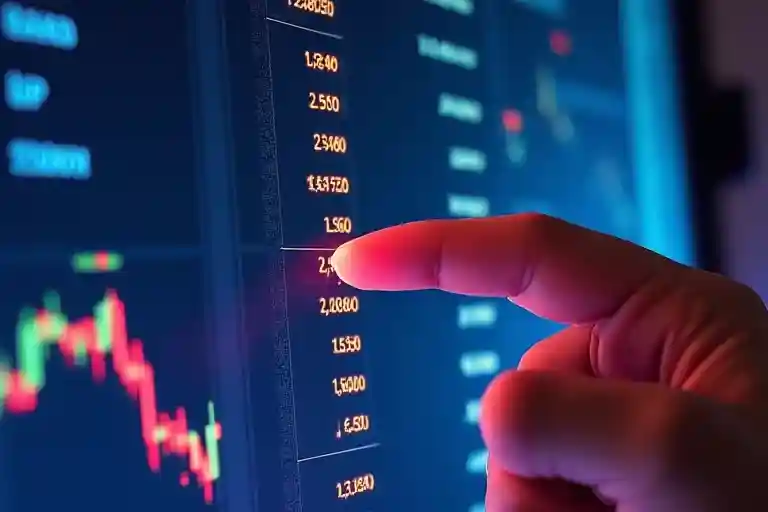Last updated: June 2025
Hey besties! So, you’re diving into the world of crypto, or maybe you’re already riding those market waves on Binance, and you’re wondering, “Am I *actually* making bank, or am I just collecting cool-sounding coins?” Trust me, I’ve been there. Staring at those charts can feel like trying to read an alien language sometimes. But guess what? Understanding your profits and losses doesn’t have to be a total headache. That’s where a crypto profit calculator Binance comes in clutch. This tool is basically your financial GPS in the often-wild journey of crypto trading. In this article, we’re gonna break down exactly what a crypto profit calculator Binance is, how to use it (spoiler: it’s easier than you think!), why it’s a non-negotiable for any teen investor, and some super important tips to keep your crypto journey safe and smart. We’ll even peek into how it works for Spot and Futures trading, what a liquidation calculator does (sounds intense, right?), and how to generally keep tabs on your crypto earnings. Ready to become a profit-tracking pro? Let’s gooo!
Before we jump in, if you’re curious about what crypto income even means, you might want to check out this awesome guide on what is crypto income. It’s a great primer!
Why a Crypto Profit Calculator Binance is Your New BFF
Okay, let’s be real. When you first start trading or holding crypto, it’s easy to get caught up in the excitement. Bitcoin’s price goes up – WOO! Ethereum has a good day – YAS! But are you *really* ahead? Think about it: you bought some coins at one price, maybe paid some fees (those sneaky little things!), and then sold at another price. Or maybe you’re still holding, but you want to know your potential profit if you sold *right now*. This is where a crypto profit calculator Binance becomes your best friend forever. It takes out the guesswork. You plug in some numbers, and BAM! It tells you the score. No more mental math that ends up looking like that confused math lady meme (you know the one!).
Imagine you bought 0.1 ETH while it turned into $2,000. That’s $two hundred spent. Then it shoots as much as $2,500. You’re questioning, “Awesome, $500 income!” Hold up, although. It’s $50 income for your 0.1 ETH ($250 – $200). And what about charges? Binance prices trading charges, which can be small in line with change, but they add up. A right calculator elements those in. It’s like having a exquisite-clever friend who’s a whiz at numbers, always there to offer you the lowdown. This isn’t always just about seeing green numbers; it’s about making knowledgeable selections. Knowing your real profit helps you strategize, understand which trades had been successful (and why!), and examine from those that weren’t. Plus, in case you ever need to give an explanation for your crypto sports on your parents (particularly in the event that they helped you get started – bear in mind, Binance’s most important platform has age necessities, generally 18 , so parental involvement for teens is key!), having clear profit/loss statements is a sport-changer. It suggests you’re being accountable, and who doesn’t need to appear to be a monetary genius in the making?
Binance Profit Calculator Spot
Alright, let’s talk Spot trading. This is probably where most beginners start on Binance. “Spot” basically means you’re buying or selling crypto “on the spot” at the current market price, and you actually *own* the coins you buy. Think of it like buying a cool pair of sneakers: you pay the price, and they’re yours to keep, wear, or sell later. The Binance profit calculator Spot tool, or a similar third-party crypto profit calculator, is designed specifically for these kinds of trades.
So, how does it work? Generally, you’ll need to input:
- The Coin Pair: e.g., BTC/USD, ETH/BTC, ADA/USDT.
- Buy Price: The price per coin when you bought it.
- Sell Price: The price per coin when you sold it (or the current price if you’re calculating potential profit).
- Amount: How much of the cryptocurrency you bought/sold.
- Fees: This is crucial! Binance has a tiered fee structure, often based on your trading volume and whether you use BNB (Binance Coin) to pay fees. The calculator needs this to be accurate. You might input it as a percentage.
For example, let’s say you bought 100 Cardano (ADA) at $0.30 each. Your initial investment is $30. You then sold all 100 ADA when the price hit $0.45. Your sale amount is $45. Without fees, that’s a $15 profit. But, if Binance charged a 0.1% fee on both the buy and sell trades:
- Buy fee: 0.1% of $30 = $0.03
- Sell fee: 0.1% of $45 = $0.045
- Total fees = $0.075
So your *actual* profit is $15 – $0.075 = $14.925. See? The fees might seem small, but for larger trades or frequent trading, they make a difference. A crypto profit calculator Binance for Spot trading automates this, so you don’t have to whip out your calculator app every five minutes. It helps you understand your true ROI (Return on Investment). This is super important for building good financial habits! Using tools like a crypto earnings calculator can give you smart ways to track these details. Remember, always ensure you’re complying with Binance’s terms of service, especially regarding age if you’re using an account with parental permission and oversight.
Understanding Spot Trading Fees
Those pesky prices! They’re part of existence in the crypto buying and selling world. For Spot buying and selling on Binance, costs are generally a percent of the trade amount. For example, a widespread price might be 0.1%. If you purchase $one hundred really worth of Bitcoin, your fee would be $0.10. If you sell $150 really worth of Ethereum, your price would be $0.15. What’s cool is that Binance regularly gives discounts in case you preserve and use their own coin, BNB, to pay for trading costs. This can reduce the charge by a positive percent, like 25%! So, if the usual rate was zero.1%, the usage of BNB may drop it to 0.1/2%. This is truly some thing to remember because it immediately influences your net profit.When using any crypto profit calculator Binance, always check if there’s an option to include fee rates or a section to manually input the fee amount. Accuracy here is key to knowing your real profit. Some calculators might even auto-populate current fee structures, which is super helpful. This is especially important when you’re just starting out and every little bit counts. Being aware of how much you’re paying in fees can prevent any “Wait, why is my profit lower than I thought?” moments. It’s like ordering food delivery and forgetting about the service fee and tip – the total can be a surprise if you’re not paying attention!

Binance Profit Calculator Futures
Now we’re stepping into slightly more advanced territory: Futures trading. Whoa, sounds like something from a sci-fi movie, right? But it’s a real thing on Binance. Unlike Spot trading where you buy and own the actual coin, Futures trading involves contracts that bet on the future price of a cryptocurrency. You’re essentially agreeing to buy or sell a specific crypto at a predetermined price on a specific date in the future. One big thing with Futures is **leverage**. This means you can control a large position with a smaller amount of capital. For instance, with 10x leverage, you could control $1000 worth of Bitcoin with only $100 of your own money. Sounds amazing? It can be, because profits can be amplified. But, and this is a HUGE but, losses can also be amplified. It’s like turning the volume on your favorite song way up – the good parts are louder, but so are any bad notes!
This is where a Binance profit Calculator Futures becomes absolutely essential. These calculators are more complex because they have to account for:
- Leverage: The multiplier effect on your position.
- Entry Price: The price at which you opened your futures contract.
- Exit Price: The price at which you closed your contract (or plan to).
- Quantity: The size of your contract.
- Long or Short: “Long” means you’re betting the price will go up. “Short” means you’re betting it will go down.
- Maintenance Margin & Funding Fees: Futures trading has these extra costs to consider. Funding fees are periodic payments exchanged between long and short traders.
Calculating profit or loss (often called P&L) in Futures manually is a recipe for confusion. A tiny price movement can result in significant gains or losses due to leverage. So, a dedicated crypto profit calculator Binance for Futures will ask for these specific details and show you your P&L, Return on Equity (ROE), and other important metrics. For teens, Futures trading carries *significant* risk and is generally not recommended without a deep understanding and, crucially, if you’re under 18, it’s usually off-limits or would require very careful navigation of rules with parental consent on platforms that might even allow it (which is rare for minors). Learning about it is fine, but diving in without experience and understanding leverage is like trying to do a triple backflip on a skateboard your first time out. You might get lucky, or you might get wiped out! Always, always prioritize safety and understanding before even thinking about leveraged products. For those looking for apps, exploring the best apps for earning cryptocurrency might offer simpler starting points, though “earning” methods there are different from trading profits.
Leverage: The Double-Edged Sword in Futures
Let’s talk more about leverage because it’s what makes Futures trading so different and, honestly, so much riskier, especially for beginners. Imagine you have $100. In Spot trading, you buy $100 worth of Crypto X. If Crypto X goes up 10%, your $100 becomes $110. You made $10. Nice! Now, with 10x leverage in Futures, your $100 controls a $1000 position in Crypto X. If Crypto X goes up 10%, that $1000 position becomes $1100. Your initial $100 has now effectively made $100 profit (minus fees). That’s a 100% return on your capital! Sounds like that “stonks” meme going straight up, right?
But hold on, here’s the scary part. If Crypto X goes *down* 10% with 10x leverage, that $1000 position loses $100. That means your initial $100 is WIPED OUT. This is called liquidation. Using a crypto profit calculator Binance for Futures, particularly one that includes liquidation price calculations (more on that next!), is vital. It helps you see how quickly things can go south. So, while the allure of big profits is strong, the risk of rapid losses is equally, if not more, potent. It’s not a game; it’s serious business. For teens especially, understanding this risk is paramount. If you see TikToks of people flexing huge leveraged gains, remember they rarely show the equally huge losses that are just as common. Be skeptical, be informed.
Binance Futures Calculator Excel
While Binance offers its own integrated calculators, some people are spreadsheet nerds (no shame, I see you!) and prefer to build their own or use templates in Microsoft Excel or Google Sheets. Why? Customization! With a Binance Futures Calculator Excel setup, you can track trades across different platforms, add your own notes, create custom charts, and basically tailor it to your exact needs. You could, for example, pull data from Binance (maybe via an API if you’re tech-savvy, or manual input) and have Excel automatically calculate your P&L, total fees paid over a month, your win/loss ratio, and so much more. This is like taking the pre-made Lego set (Binance’s calculator) and then using your own giant tub of assorted Lego bricks (Excel) to build something even bigger and more specific to you.
To build one, you’d need columns for things like:
- Date & Time
- Asset (e.g., BTCUSDT Perpetual)
- Long/Short
- Entry Price
- Exit Price
- Quantity/Contract Size
- Leverage Used
- Initial Margin
- Fees (Trading Fees, Funding Fees)
- PNL (Profit and Loss)
- ROE (Return on Equity)
Then you’d use Excel formulas to do the calculations. For PNL on a long position, a simplified formula might be: `(Exit Price – Entry Price) * Quantity`. For a short, it’d be `(Entry Price – Exit Price) * Quantity`. Then you’d subtract fees and factor in leverage for ROE. It sounds a bit complex, and it can be, but the control it offers is a big plus for serious traders. However, for most teens starting out, the built-in Binance calculators or simpler third-party web tools for a crypto profit calculator Binance are more than enough and much less prone to formula errors (which can be costly!). If you’re interested in how much money you *could* make (or lose, always remember the risk!), some general articles like how much money can you make with crypto provide broader context, but always take specific figures with a grain of salt as crypto is volatile.
Binance Liquidation Calculator
Okay, “liquidation.” Sounds like something a superhero villain would do, right? “I will liquidate your assets!” In the context of leveraged trading on Binance (especially Futures), liquidation is a very real and not-so-fun concept. When you use leverage, you’re borrowing funds to increase your position size. If the market moves against your position significantly, your losses can exceed your initial margin (the money you put up). To prevent the losses from exceeding your account balance, the exchange (Binance) will automatically close your position. That’s liquidation. Your initial margin is lost. Ouch. It’s the market saying, “Game Over” for that trade.
A Binance liquidation calculator is a tool that helps you estimate the price at which your leveraged position would be liquidated. This is SUPER DUPER IMPORTANT. Knowing your liquidation price allows you to:
- Set Stop-Loss Orders: You can set an order to automatically close your position *before* it hits the liquidation price, thereby limiting your losses. This is like having an eject button in a fighter jet.
- Manage Your Leverage: If the liquidation price is too close to your entry price for comfort, it means you might be using too much leverage. The calculator can help you decide to reduce it.
- Understand Risk: It visually shows you how much room your trade has to move before things go really bad.
These calculators will typically ask for your entry price, the quantity of the contract, your account balance (or the margin allocated to that trade), and the leverage used. It then crunches the numbers based on Binance’s specific maintenance margin requirements (the minimum amount of equity you must maintain). For instance, if you go long on ETH at $3,000 with 20x leverage, the liquidation calculator will tell you that if ETH drops to, say, $2,880 (this is just an example figure), your position will be liquidated. This is a critical safety tool. Ignoring it when trading with leverage is like going deep-sea diving without checking your oxygen tank. Not a good idea! Remember, understanding whether you even have to report crypto earnings for tax purposes is another layer of responsibility that comes with trading, even if you’re just making small amounts.

Crypto Spot Profit Calculator
While we’ve talked about the Binance-specific Spot calculator, it’s good to know that a general Crypto Spot profit calculator works on the same principles and can be used for trades on any exchange, not just Binance. So, if you’re dabbling on Coinbase, Kraken, or any other platform, the concept is identical. You bought low, you (hopefully) sold high, and there were fees in between. These calculators are often simpler than Futures calculators because they don’t need to factor in leverage, margin, or funding rates. It’s more straightforward: (Sell Price * Quantity) – (Buy Price * Quantity) – Fees = Profit/Loss.
Many websites and crypto apps offer these. Some popular crypto portfolio trackers also have them built-in. When looking for a good generic Crypto Spot profit calculator, make sure it allows you to:
- Specify different currencies (e.g., calculate profit in USD, EUR, etc.).
- Easily input buy and sell prices.
- Clearly input the quantity of crypto traded.
- Have a field for commission/fees, either as a percentage or a flat amount.
For example, you buy 0.005 BTC at $40,000/BTC. Investment = $200. Fees = 0.2% ($0.40).
You sell that 0.005 BTC at $42,000/BTC. Sale amount = $210. Fees = 0.2% ($0.42).
Your gross profit before fees is $10. Your total fees are $0.82.
So, your net profit is $10 – $0.82 = $9.18.
A calculator makes this instant and error-free. It’s a fundamental tool for anyone involved in crypto trading, helping you keep an accurate record of your performance. This is especially true if you are exploring ways of earning free crypto through airdrops or using a crypto faucet to earn free crypto, as you’ll want to calculate the value and potential profit if you decide to trade those earned coins. You can even check out lists like Top 10 Upcoming Crypto Airdrops in 2025 to see potential opportunities, but always calculate profits carefully if you trade them.
Binance Fee Calculator
We’ve touched on fees a lot, because, well, they’re unavoidable! A dedicated Binance fee calculator focuses *solely* on calculating the trading fees you’ll pay on Binance for a specific trade. This can be super useful *before* you even make a trade, to understand the costs involved. Binance’s fee structure can have several variables:
- Your VIP Level: Based on your 30-day trading volume and/or BNB balance. Higher VIP levels get lower fees. Most beginners will be at VIP 0.
- Using BNB for Fees: You usually get a discount (e.g., 25% off Spot trading fees, 10% off Futures trading fees) if you choose to pay fees with Binance Coin (BNB).
- Maker vs. Taker: A “maker” order adds liquidity to the order book (e.g., you place a limit order that doesn’t fill immediately). A “taker” order removes liquidity (e.g., you place a market order that fills immediately). Makers often have slightly lower fees than takers.
- Spot vs. Futures: Fees for Spot and Futures markets are different.
A good Binance fee calculator will let you select your market (Spot/Futures), input your trade size, specify if you’re using BNB for fees, and possibly your VIP level and whether you’re a maker or taker. It then spits out the estimated fee. Why is this helpful on its own? For high-frequency traders or those dealing with very small profit margins, understanding the exact fee can determine if a trade is even worth making. For us teens, it’s about transparency and avoiding surprises. If you’re trying to scalp a tiny profit, but the fee eats it all up, what’s the point? It’s like finding a dollar on the street but having to pay 90 cents to a “finder’s fee service” – not much left for your slushie fund! Being smart about fees is a core part of using any crypto profit calculator Binance effectively.
Staying Safe & Smart with Your Crypto Profit Calculator Binance
Using a crypto profit calculator Binance is awesome for understanding your numbers, but it’s just one piece of the puzzle. Especially for teens, navigating the crypto world requires being extra careful. Here are some *super important* safety and smarts tips:
- Parental Guidance is Key: Look, most major exchanges like Binance officially require users to be 18+. If you’re younger and using an account, it’s likely under a parent or guardian’s name and supervision. ALWAYS be open with them about what you’re doing. Their experience and oversight are invaluable. Don’t try to go it alone if you’re underage; it can lead to account freezes or loss of funds.
- Start Small, Learn Big: Don’t YOLO your entire birthday money or savings into crypto hoping to get rich quick. That’s how people get rekt (crypto slang for wrecked/ruined). Start with very small amounts you can genuinely afford to lose. The goal, especially at first, is to learn, not to become a millionaire overnight.
- Security First, Always: Use strong, unique passwords for your Binance account. Enable Two-Factor Authentication (2FA) – preferably using an app like Google Authenticator, not just SMS. Be super wary of phishing scams (fake emails or websites trying to steal your login info). If something looks sus, it probably is! That “Too good to be true?” feeling? Trust it.
- Understand Volatility: Crypto prices can go up AND down, like, a *lot* and very quickly. That TikTok meme of the dude on a rollercoaster perfectly describes crypto sometimes. Don’t panic sell at the first dip or get FOMO (Fear Of Missing Out) and buy at the peak of a hype wave. Emotional trading is usually bad trading.
- It’s Not Financial Advice: Articles like this one, YouTube videos, stuff your friends say – it’s for education and entertainment. It’s not professional financial advice telling you what to buy or sell. Do Your Own Research (DYOR) is a huge motto in crypto for a reason.
- Calculators are Tools, Not Crystal Balls: A crypto profit calculator Binance tells you about past trades or *potential* outcomes of current prices. It cannot predict the future. No tool can.
- Beware of Scams: The crypto space, unfortunately, attracts scammers. Promises of guaranteed high returns, “secret” trading bots, DMs from “support” asking for your seed phrase (NEVER share that!) – run away! If you are exploring things like crypto faucets or airdrops, stick to well-known sources like Airdrops.io to minimize risk.
Using these tools responsibly is part of growing your financial literacy. It’s not just about the numbers; it’s about the habits you build. If you are also looking into ways to potentially earn crypto without direct trading, exploring things like legit crypto earning apps that are free could be an option, but always with caution and research.
Crypto Calculator: The Big Picture
Beyond just Binance, a general Crypto calculator can encompass a range of functions. We’ve focused on profit calculation, but these tools can also help with:
- Conversions: Quickly convert one crypto to another (e.g., BTC to ETH) or crypto to fiat (e.g., ETH to USD) at current market rates.
- Mining Profitability: If you were into crypto mining (though it’s pretty complex and resource-intensive now), calculators could estimate potential earnings based on hash rate, electricity costs, and coin price.
- Staking Rewards: Estimate potential earnings from staking your crypto (locking it up to support a network and earn rewards).
- Portfolio Tracking: While not strictly calculators, many portfolio apps integrate calculation features to show your overall crypto net worth and performance across all your holdings.
The core idea is to bring clarity to your crypto finances. Think of it like this: if you’re playing a video game, you want to know your score, your health points, your inventory. A crypto calculator, especially your crypto profit calculator Binance, is your financial dashboard in the game of crypto. It helps you make sense of the numbers so you can play smarter. Understanding how much you *could* earn, for instance, by checking a resource about how much you can make with crypto, should always be paired with the realistic use of a profit calculator to see actual, not just hypothetical, results.
Here’s a quick comparison of using a Spot Profit Calculator vs. a Futures Profit Calculator:
| Feature | Spot Profit Calculator | Futures Profit Calculator |
|---|---|---|
| Primary Use | Calculating profit/loss on direct crypto purchases/sales. | Calculating profit/loss on leveraged futures contracts. |
| Key Inputs | Buy price, sell price, quantity, fees. | Entry price, exit price, quantity, leverage, fees, position (long/short). |
| Complexity | Simpler, more straightforward. | More complex due to leverage and additional fee types (e.g., funding rates). |
| Risk Indication | Primarily reflects market price risk. | Reflects market price risk AND high risk from leverage (liquidation risk). |
| Common Outputs | Net Profit/Loss, ROI. | PNL (Profit and Loss), ROE (Return on Equity), Liquidation Price (if integrated). |
| Best For | Beginners, those holding actual crypto assets. | Experienced traders who understand leverage and risk management. (Caution for teens!) |
Remember, choosing the right tool depends on what you’re doing. If you’re just buying and holding some Dogecoin because a TikTok told you to (please DYOR too!), a Spot calculator is your friend. If you’re learning about advanced trading strategies (again, with extreme caution and likely observation rather than participation for younger teens), then understanding how Futures calculators work is important. The key is the crypto profit calculator Binance helps you see the real score.
Conclusion
Phew! We’ve covered a TON about the crypto profit calculator Binance and why it’s such an essential tool, especially for teens dipping their toes (safely!) into the crypto ocean. From understanding Spot and Futures calculations to the nitty-gritty of fees and the scary (but crucial) concept of liquidation, knowing your numbers is power. It transforms you from a passive passenger to an active, informed participant in your financial journey. This isn’t about becoming a Wall Street wolf overnight; it’s about building smart habits, understanding risk, and using the tools available to make informed decisions. The crypto profit calculator Binance is one of your best first steps to demystifying crypto trading.
So, what’s next? Don’t just read this and forget it! If you are exploring Binance (with parental permission and oversight if you’re under 18, please!), try to find their built-in calculators. Play around with hypothetical trades. See how fees and price changes impact potential profits. The more comfortable you get with these tools, the more confident and responsible you’ll become.
We’d love to hear from you! What are your biggest questions about crypto profits? Got any experiences (good or bad!) with calculating your earnings? Drop a comment below! And hey, if you found this useful, why not share it on TikTok or with your group chat? Let’s help everyone get smarter with their crypto!
Stay Updated! The crypto world changes FAST – new platforms, updated fee structures, changing regulations. Keep checking back on zana.website for the latest guides and tips to help you navigate it all. The journey with your crypto profit calculator Binance is just beginning!
Frequently Asked Questions
1. How to calculate your profit in Binance?
To calculate your profit in Binance for Spot trading, subtract your total buy cost (including fees) from your total sell revenue (minus fees). Binance often has built-in P&L (Profit and Loss) analysis tools for your trade history. For Futures, it’s more complex due to leverage, but Binance provides a Futures calculator for this.
2. How to earn $100 dollars on Binance?
Earning $100 on Binance can be through trading (Spot or Futures, with risk), staking, savings products, or participating in launchpad events. There’s no guaranteed way; trading involves risk of loss. Always research, start small, and understand the risks. Using a crypto profit calculator Binance helps track progress from trading.
3. How do you calculate crypto profit?
Generally, crypto profit is (Selling Price per coin * Number of Coins) – (Buying Price per coin * Number of Coins) – Total Fees. This gives your net profit. For accuracy, always include all transaction fees. Many online crypto profit calculators can do this for you easily.
4. How much can I earn from Binance per day?
There’s no set amount you can earn from Binance per day; it’s highly variable and not guaranteed. Earnings depend on your investment amount, trading strategy, market volatility, and luck. Trading crypto carries significant risk, and you can also lose money. Focus on learning, not specific daily income targets, especially as a beginner.









